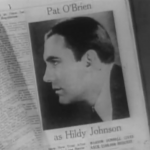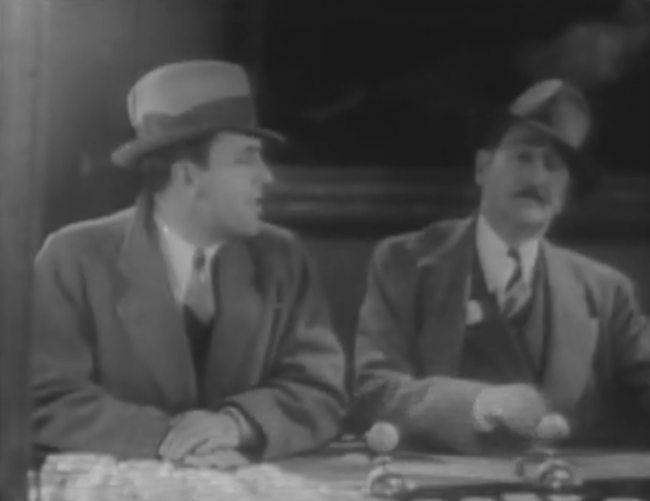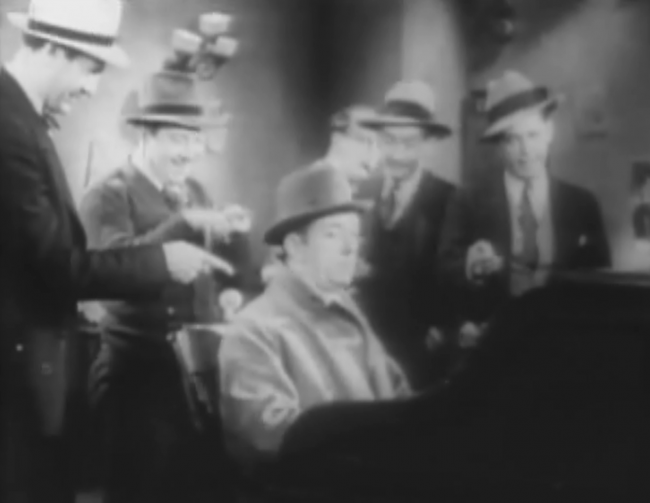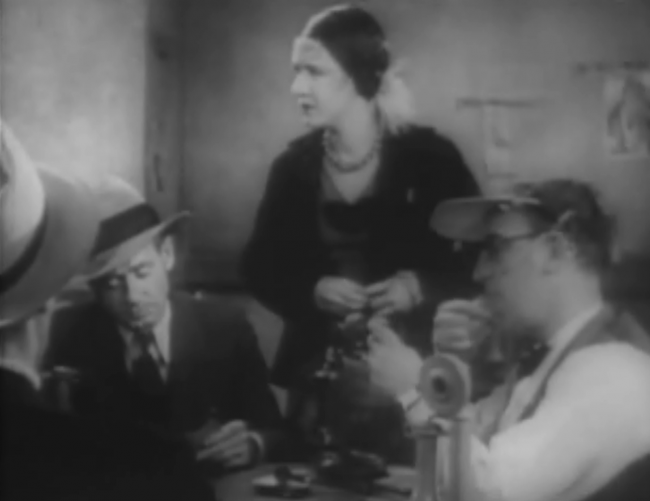 |
 |
 |
| Hildy Johnson Pat O’Brien |
Walter Burns Adolphe Menjou |
Peggy Grant Mary Brian |
 |
 |
 |
| Bensinger Edward Everett Horton |
Earl Williams George E. Stone |
Molly Mae Clarke |
| Released by United Artists | Directed By Lewis Milestone |
||
Proof That It’s Pre-Code
- Digging through his desk, Bensinger finds a discarded woman’s slip.
- Plenty of dark jokes about sexual deviancy, murder, and mayhem.
- One of the reporters offers the mayor a very special gesture– see the comments for more details.
- Most of the main characters have an absolutely callous respect for life or dignity, with most readily willing to let a dubiously sane man die just for their own gain.
- “I was in love with someone once. It was my third wife.”
- “What kind of language is that?!”
- The final line contains an audible crash behind it to censor the word ‘bitch’.
The Front Page: Fourth Estate Gone Wild
“This story is laid in a mythical kingdom.”
The Front Page is a classic. I’m talking about the original stage play here, the Ben Hecht and Charles MacArthur scripted work that made its debut in New York in 1928 and became one of the American masterworks. It’s been filmed with minor adjustments a healthy number of times, such as when Billy Wilder put Walter Mathau and Jack Lemmon in it in in 1974, and it’s been filmed with major adjustments, such as gender flipping it for the alright Cary Grant/Rosalind Russell flick His Girl Friday (1940). And then there’s been the updates, like the cable television-set better-left-forgotten Kathleen Turner/Burt Reynolds vehicle Switching Channels (1988). It’s had an even longer life on the small screen and stage, where it’s seen play at least once a decade.
Why has it endured when so many of its contemporaries are seen as dated or defunct? The 1931 film version, the first and the one most contemporaneous to its depicted events, may offer some clues. Besides showcasing the zippy energy that the play relies on, it captures a sense of nihilism that the country was getting dragged into as The Depression kicked off. The only two selfless people in the film is the crazy man sentenced to death and the kindly prostitute who wants to help him. Every other character in the movie resents the two immeasurably, most unarguably frustrated as to what these two people mean to their own cynical, heartless existences.
If you’ve somehow missed every other iteration of the story (or have seen one and just didn’t know it), here’s the rundown: Hildy Johnson (Pat O’Brien here) is getting married. He’s not only taking on a very sweet, innocent wife (Mary Brian), but a mother-in-law who will accompany them as they move from Chicago to New York.
There’s a big problem, though: Hildy is a newspaperman under the banner of monstrous editor Walter Burns (Adolphe Menjou). Burns has gone to great lengths to keep good employees around, up to and including getting them arrested. Hildy runs Walter’s beat at city hall, and the betrayal is doubly painful since it’s the night of the execution of Earl Williams (George E. Stone). Williams is a mentally unbalanced communist who shot a black police officer while he was in a confused state– perfect grist for the mills for the mayor’s appeal to the African-American vote.
The other gathered newspaper journalists, including fussy Besinger (Edward Everett Horton), are cranky because Sheriff Hartman (Clarence Wilson) won’t move the execution up to suit their morning deadlines. Meanwhile, prostitute Molly Malloy (Mae Clarke) rails against the newspapermen for ignoring the fact that Earl is being crucified only for political gain. They don’t care– he’s dying for their circulation numbers as well.
Into this fray comes Hildy to say his final goodbyes, but that’s derailed once Williams escapes and the entire town of Chicago tears itself apart at the seams. As Burns swoops in and takes a place on Hildy’s shoulder as the poor man’s own personal devil, can Hildy make it out of Chicago with his wits about him? Oh, and what about Williams– does he make it out alive?
The plot of The Front Page sounds pretty dire, but it’s a comedy, and a sharp one of that. It plays with equal parts of wordplay and outrage, gleefully taking a cadre of amoral characters and letting them loose. At the forefront is Burns, who is gleefully nasty and happy to torture Hildy. He even has Hildy’s future mother-in-law kidnapped just to keep her mouth shut– but Menjou and the character never become unlikeable. That may be because while Burns is clearly operating under a profit motive, his profits grow as his machinations bite the ass of conniving government officials, making him a weird, wonderful anti-hero.
Hildy is more likeable, a bridge between the cruel squad of newspapermen who crank call victims in their down time and the flummoxed, hopeless Molly. He knows the incompetence and evil of both the government and the newspaper, but he’s the only one with the ability to dig up his emotions as needed. In the dark jungle of amorality, Hildy is the only one still looking for a light.
The camera work in The Front Page is dazzling. While a lot of early-30s movies were very measured and static, director Lewis Milestone moves confidently with skill. He’s clearly experimenting with connecting sound to images to horrify, amuse, and underline the story’s morbid leanings. Take the film’s opening, as we see a bag of flour meet the gallows (practicing for Earl’s eventual fate), matched by quick cuts establishing the location of the press room where most of the movie takes place. The snappy dialogue is connected by editing, including one dizzying sequence where the mocking journalists are whip panned through while the impotent Sheriff begs them to stop.
Milestone creates a breathing universe, perhaps best exemplified by the moment where Molly comes in and berates the journalists for the first time, scratching the surface of their humanity if only for a brief moment. While much of the film is set in a single room (as the stage play was set entirely there), Milestone cuts away to speakeasies and newspaper offices to give the film’s location of Chicago an extra layer of flavor. It’s a loose, ravenous atmosphere, and again speaks to why the film was so popular to adapt and re-adapt– there was no time quite like Chicago in the 20s, and the movie and the play capture that lawless, complicated world flawlessly.
The Front Page is a well-made, zippy and energetic newspaper film. Its success started a cycle of cynical newspaper films, both dramatic and comedic, and gave starts to actors like Pat O’Brien, Mae Clarke, Frank McHugh, and more. The Front Page is one of the first movies that showed what talking cinema could do, and it’s an essential watch to see as a stopgap between silent film and the sophisticated talkies that were on their way in.
Gallery
Hover over for controls.
Trivia & Links
- For both a Best Picture nominee and a movie in the public domain, this is surprisingly underwritten about– I’m afraid it’s a case where the many remakes and the poor quality of the prints turn people off. Too bad.
- According to Mae Clarke’s autobiography, Pat O’Brien was stunned when he learned that he’d gotten the Hildy Johnson role as he’d played Burns on stage and expected to be cast as such. He was overjoyed as being cast as the leading man as it led the way to future parts as male romantic leads.
- The NYU Film Notes for this one does a better job comparing and contrasting this version and the better-remembered His Girl Friday than I ever could.
There is no question that the original is by far the better film, it’s characters real flesh and blood people as opposed to the cardboard figures of the remake. Yet “His Girl Friday” is undeniably funnier; it downplays some of the political undertones, creates a frenzied pace primarily through its handling of actors and its non-stop overlapping dialogue, and some hilarious new dialogue has been added. Too, some of the supporting casting is much better […] Both films certainly have a major place in film history.
- 20/20 Movie Reviews gives this one a mixed review, but makes a good point about its general attitude:
The mordant humour here pulls few punches, even for a pre-code movie, and the reporters’ lack of humanity is almost disturbing to watch at times. These guys have no regard for each other or human life in general, having been in the job so long that they’ve become immune to sentiment or sympathy. The politicians, too, place so little value on the life of a man sentenced on the basis of dubious evidence that they suppress a reprieve so that the innocent man’s hanging can go ahead before the forthcoming elections.
It’s a pretty grim picture of a world in which those who show any spark of human warmth or decency are brushed aside by people who have little interest in a truth that messes with either their beliefs or their deadlines. It’s therefore a measure of the quality of Hecht and MacArthur’s writing that they frequently flirt with the darkness without ever submerging their audience in it completely. The tone remains light throughout, no matter how distasteful the subject, thanks largely to a style that pre-dates — but is recognisable as — screwball comedy. That means everyone bellows their lines at double-quick speed, which is just as well considering the atrocious sound quality of most prints available today.
- The TCMDB entry (scroll down, it discusses the Wilder version first for some reason) talks about the play’s origins:
Hecht and MacArthur, the celebrated collaborators who co-authored other stage hits and screenplays and co-directed several films of the 1930s, began their writing careers as reporters in 1920s Chicago. In his memoir Charlie, Hecht recalled their working relationship on their first joint effort, the stage version of The Front Page: “We were both writing of people we had loved, and of an employment that had been like none other was ever to be…Our procedure was established on the first day. It continued, unchanged, through 20 years of play and movie writing. I sat with a pencil, paper and a lap board. Charlie walked, lay on a couch, looked out of a window, drew mustaches on magazine cover girls, and prowled around in some fourth dimension.” To determine who would get first billing in their collaboration, the pair flipped a nickel, and Hecht correctly named it tails.
Awards, Accolades & Availability
- This film is in the public domain, so it ain’t hard to find. You can check it out on Archive.Org.
Comment below or join our email subscription list on the sidebar! |
||
 |
 |
 |
 |
 |
|











15 Comments
maltydog · August 10, 2015 at 2:12 am
Well worth noting that this is now available in an excellent Blu Ray from Kino restore from 35mm elements from the Library of Congress. No need to endure bad prints and sound anymore.
Danny · August 16, 2015 at 1:01 pm
… wait? OH, CRAP. It is! Put on my wishlist. Thanks!
Tony · August 10, 2015 at 11:22 pm
I think that watching and examining the three major film adaptations of The Front Page (1931,1940,1974) is a great way to see how Hollywood evolved and depicted the same story in the Pre-Code era, the Golden Age and the post-classical era. While I consider all three films vastly different from each other but quite enjoyable, the more well-known later adaptations of the play have made this 1931 classic a highly underrated one.
Danny · August 16, 2015 at 1:05 pm
I agree, and you make an excellent point. Thanks!
Ken Schellenberg · August 17, 2015 at 11:22 pm
Nice overview – I watched the new Kino Blu-Ray – the picture is great throughout but the sound quality varies from reel to reel – which is a pity. It’s almost unlistenable in the first reel, but it gets better.
One more item to add to your “Proof That It’s Pre-Code” list – one of the reporters “flips off” the mayor.
It’s the scene where the mayor and the sergeant (?) are talking and a reporter breezes past them, picks up a phones and dictates a quote from the governor how the guv’s glad the election is Tuesday to save the taxpayers the cost of impeaching the mayor. All the while the reporter stares down the mayor. After he hangs up, the reporter gives the mayor the bird as he walks away.
When we did a freeze frame (after a “Wha? Did we see that?”) the Blu-Ray conveniently freezes on the report’s smirk and extended middle finger to the mayor!
Danny · September 1, 2015 at 5:45 am
I definitely didn’t catch that! I’ll have to add it in, thanks!
Peter · July 6, 2018 at 2:43 am
There is another restored version of this film on The Criterion Collection’s His Girl Friday restored in 2016 from a 35 mm version of the film kept by Howard Hughes. They have a documentary about its restoration and pointed out some interesting things. Apparently there are three versions of the film (with 3 different takes for each shot making each film slightly different). There is version 1 (Howard Hughes’ version) which is the original American film, there is version 2 which was made for the UK, and version 3 which was made for Europeon and other foreign markets (Library of Congress version). There are slight variations in each version depending on how much they thought they could get away with for each market. For the American version there is no middle finger for the mayor, the reporter just puts his hand up. Apparently the gesture was too controversial or troublesome for American audiences.
Judy · August 22, 2015 at 5:29 am
I love this version as well as His Girl Friday. Great to see Pat O’Brien in that type of role – which later went to his best friend Cagney while he played the priest. As someone who has worked in local newspapers for many years, I think it stands out a mile that Hecht and MacArthur knew their stuff. Fantastic script – you can see why it is always being revised. Mae Clarke is also excellent in this – great to see your series of postings on her.
Danny · September 1, 2015 at 5:55 am
Thanks, and I agree– this is O’Brien at his best.
Mark · January 11, 2016 at 8:49 am
My copy is a bit grainy but it looks to me like some of the photos hanging on the wall in the press room have nudity. Am I seeing that right? This would also be evidence of pre-code.
Danny · February 16, 2016 at 12:34 pm
That’s a good point. If I ever get a copy of the blu-ray, maybe we’ll know for sure!
Rich Graham · February 19, 2017 at 1:27 pm
I saw the recent restored version on the big screen at a local movie theater recently. There are definitely several pictures of nude women on the wall. They are in plenty of scenes.
Nivek · June 23, 2017 at 9:22 pm
I was just going to post this. I have only seen the old grainy copies that run on TCM–apparently they haven’t gotten the restored version–but even in that one you can tell the pictures on the wall are nudie pictures. You can especially tell in close-ups of the front door as people enter and leave.
Barbara Williams. · February 17, 2018 at 5:58 pm
I’ve seen this movie a few times. This time,maybe because I just read a history book about WWI,I’m wondering if earl williams, who’s an anarchist, is intended to look like Gavrilo Princip, or if it’s a coincidence.
Mrs H · July 17, 2018 at 1:26 pm
Maybe he is meant to resemble Nicola and/or Bart, the pair of Italian anarchists who were executed on sketchy evidence in the 1920s for the murder of a bank vault guard. There was a huge public protest to save them, to no avail. Joan Baez wrote a song about it decades later.
Comments are closed.